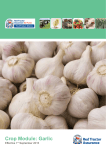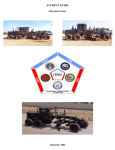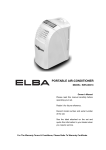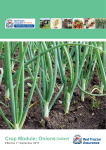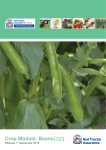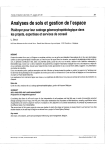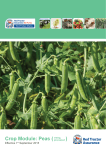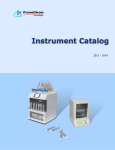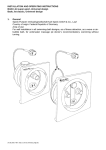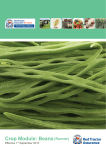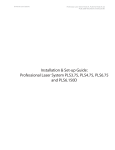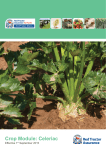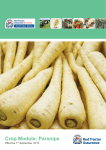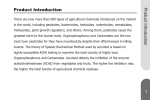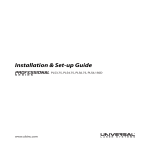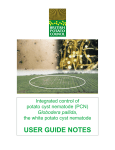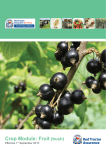Download Crop Module: Onion (bulb)
Transcript
Crop Module: Onion (bulb) Effective 1st September 2015 Welcome T his crop specific module for protected bulb onions has been written to complement and avoid duplicating the generic principles of the Red Tractor Farm Assurance Fresh Produce Scheme standards. It is advisable to read the Red Tractor Farm Assurance Fresh Produce standards before reading this crop specific module. This module is designed to stimulate thought in the mind of the reader. It contains crop specific guidance and standards, where applicable, in addition to the requirements stated in the generic Fresh Produce standards. Within this module the important requirements outlined in the crop specific standards section will be verified during the Red Tractor Farm Assurance assessment and compliance will form a part of the certification/approval decision. Disclaimer and trade mark acknowledgement Although every effort has been made to ensure accuracy, Assured Food Standards does not accept any responsibility for errors and omissions. Trade names are only used in this module where use of that specific product is essential. All such products are annotated® and all trademark rights are hereby acknowledged. General Introduction Following a systematic approach will help growers identify and manage the risks involved in crop production. This module is based on a typical crop production process and food safety, health & safety, environmental and quality hazards are identified. Appropriate controls may then be established to minimise risk. Food safety and health & safety issues always take precedent over quality and environmental controls. The layout of this module follows the same structure as that used in the Red Tractor Farm Assurance Fresh Produce Standards. The content of the module is reviewed prior to the issue of updated editions. The review process considers both new developments and all relevant technology which has emerged since the last review was completed and which have been found to be both workable by the grower and beneficial to the environment. The aim is to transfer such information and technologies to growers. Acknowledgements Red Tractor Farm Assurance Fresh Produce gratefully acknowledges the contribution of all consultees in the preparation of this protocol, particularly Andy Richardson, Allium & Brassica Centre, Wash Road, Kirton, Lincs. Notes: Pesticide Information The Red Tractor Fresh Produce team has been working with Fera to provide tailored access to the LIAISON database for all Red Tractor Fresh Produce members. This system allows individual growers access to all information for plant protection products approved for use under the Red Tractor Fresh Produce Scheme. LIAISON can be accessed under the Produce tab via the “Checkers and Services” page where you will also find a user manual. Searches will be filtered specifically for the crops for which you are registered. Once you have logged onto the site and clicked on the LIAISON hyperlink you will be directed to the LIAISON home screen. You will need a username and password and these will be sent once you have registered: http://assurance.redtractor.org.uk/rtassurance/ services/Registration/members.eb . Front cover image credit: Allium and Brassica Agronomy Ltd. 1 Red Tractor Assurance for Farms – Crop-specific Module: Onion (bulb) © Assured Food Standards 2015 Content Contents ADDITIONAL REQUIREMENTS AGAINST CURRENT STANDARDS 02 CROP SPECIFIC STANDARDS02 CHOICE OF VARIETY OR ROOTSTOCK AND PLANT HEALTH CERTIFICATION 03 SITE AND SOIL MANAGEMENT 03 ENVIRONMENTAL PROTECTION AND CONTAMINATION CONTROL04 PEST, DISEASE AND WEED CONTROL 04 NUTRITION 08 IRRIGATION09 HARVEST AND STORAGE 09 RESIDUES AND CONTAMINANTS 11 APPENDIX 1: TYPICAL APPLICATION RATES FOR NUTRIENTS 12 APPENDIX 2: GUIDELINES ON MINIMISING PESTICIDE RESIDUES12 APPENDIX 3: NEMATICIDE APPLICATION PROTOCOL13 ADDITIONAL REQUIREMENTS AGAINST CURRENT STANDARDS None for this crop module CROP SPECIFIC STANDARDS STANDARDS HOW YOU WILL BE MEASURED RECORDS (to be kept for 2 years) CQ.52.a Waste trailers must be sheeted at all times when in transit n CQ.52.b Store cleaning records Stores must be cleaned before onions are stored in bulk Red Tractor Assurance for Farms – Crop-specific Module: Onion (bulb) © Assured Food Standards 2015 2 GUIDANCE CHOICE OF VARIETY OR ROOTSTOCK AND PLANT HEALTH CERTIFICATION CHOICE OF VARIETY Growers should take in to account varietal yield, quality and storage characteristics to optimise the performance of onion crops. Growers must document and justify any seed applied pesticides. PROPAGATION For transplanting bulb onions, modular trays are generally used; normally with 308 to 345 cells per tray with 5 seeds per cell. There is presently no alternative to using peat compost but 5-8% sand is often used to improve drainage and the weight of the cell. This technique is however less than 0.1% of total bulb onion production. High nitrogen compost is recommended with a high nitrogen and phosphate feed prior to transplanting. Propagators Growers should ensure that propagators are registered with Fera’s Plant Health and Seeds Inspectorate under the EU Plant Health Regulations. Propagators should only use pesticides agreed with the producer/purchaser, should keep accurate detailed records of pesticide application and these should be confirmed on receipt of delivery. Propagators should accept the responsibility to produce plants free from pest and disease. Set producers Onion and shallot sets should be approved under the NAK-T inspection scheme or a similar inspection system, prior to despatch. Set producers should be registered under the EU Marketing scheme and the sets carry the appropriate plant passport. All sets should be drenched, where justified, with an approved fungicide, and dried prior to despatch. Some fungicide treatments control neckrot that can cause serious post-harvest losses. SITE AND SOIL MANAGEMENT SITE HISTORY Soil type and latitude have a major influence on the production system that can be used and on the quality of resulting bulbs. The most suitable soil types are sandy loam to sandy clay loam, very fine sandy loam (silts), and some peatbased soils. The crop produces a coarse rooting system and whilst requiring a degree of firmness for good root/soil contact, the soil should be free from compaction and well drained. Irrigation is an essential requirement for production on sand and lighter soil types. ROTATION AND CROP SITING Rotation has a role in minimising disease problems but may not prevent the build-up of the two major soil-borne diseases over the course of time. It is generally accepted that the minimum rotation should be 1 in 4 years and ideally up to 6 years. It is recommended that onion crops should be separated by a minimum distance of 800m when production is based on different systems - i.e. sets, spring drilled and overwinter crops. Isolation reduces the spread of wind-dispersed foliar diseases. However, this may only be possible to a limited extent in commercial practice. CHOICE OF PRODUCTION SYSTEM Bulb onions can be produced in a number of different ways: i. O ver-wintered, either seed direct-drilled in August/ September for harvest the following June or increasingly as sets planted in late September/October for harvest the following June/July. ii.Spring planted sets for harvest in July/August. iii.Spring drilled from seed for harvest late August/ September. iv.Spring drilled varieties, raised as multi seeded modules propagated under glass in February for planting in April. Now very much in decline. Shallots are generally produced in two ways: i. Spring planted sets for harvest in June/July. ii.Spring drilled from seed for harvest in July/August. 3 Red Tractor Assurance for Farms – Crop-specific Module: Onion (bulb) © Assured Food Standards 2015 The choice of cultivar within each section currently has only a minor influence on disease susceptibility, although varieties with Downy Mildew resistance are now commercially available. Foliar diseases are encouraged by increasing population density and by humid conditions. Over-wintering types are the most susceptible to leaf diseases with spring-drilled being the least susceptible. Soil type as well as requirements for continuity of production will influence choice of production system. Choice of variety should be made with reference to NIAB information. LATITUDE Bulbing is influenced by day length and hence site selection is influenced by latitude. In general terms, direct drilling is more successful for crops produced south of the Humber. Further north crops are more generally established from sets or modules. ENVIRONMENTAL PROTECTION & CONTAMINATION CONTROL THE BASIC APPROACH TO CROP PROTECTION Bulb onions are subject to a number of disease problems and it is a guiding principle that pesticide inputs should be minimised through prevention rather than cure. Integrated crop management An integrated approach should be adopted using the following steps: Good management and planning a. C areful site selection to avoid potential or previous problems b. Sensible crop rotation to avoid build-up of soil-borne problems or disease carry over from one crop to the next. Cultural preventative techniques a. Good crop and field hygiene to minimise spread of soil borne problems by cultivation equipment etc. This is particularly important with the increasing trend to contract onions ‘green’ from clean sand land. There is therefore a greater risk of transporting disease more widely with machinery b. Avoiding spread of onion waste except on farms unlikely to be involved in onion production c. Minimise wind blown debris from harvesting and grading operations. Crop residues should be ploughed in as soon as possible. Waste trailers must be sheeted at all times in transit. Corrective action Where control of pests/diseases is still required the following approach should be adopted: a. Establish the need to take corrective action by regular monitoring and reference to forecasting techniques, when available b. Consider effect of prevailing weather conditions c. Where action is required, as a principle, the possibility of using biological or cultural methods should be considered first. If chemical control is needed the following points should be considered, subject to achieving effective control: n use the least toxic and persistent product. n use the most selective product to reduce the impact on naturally occurring beneficial organisms. n use the minimum effective dose rate. n use appropriate application methods with properly maintained equipment. Growers should ensure that the minimum number of chemical applications are made to achieve good control, for example in controlling downy mildew (peronospora destructor) and leaf spot (Botrytis squamosa). N.B. exceeding the maximum individual and maximum total dose rate is illegal under COPR. PEST, DISEASE AND WEED CONTROL PEST CONTROL Bean seed fly (Delia florilega/Delia platura) Attack by the bean seed fly is often confused with onion fly attack, although losses due to onion fly are relatively rare in the UK. This pest is more prevalent on winter crops sown in August/September when seed treatment with tefluthrin is a routine treatment south of the Wash. Occasionally an application of chlorpyrifos (note: no approval for the use of chlorpyrifos on shallots) may be necessary for control of second and subsequent fly generations as tefluthrin is only typically persistent enough to control the first generation. Red Tractor Assurance for Farms – Crop-specific Module: Onion (bulb) © Assured Food Standards 2015 4 The need for control of both bean seed fly and onion fly by seed treatment should be based on previous experience. Stem and bulb eelworm (Ditylenchus dipsaci) Eelworm attack is initiated by wet conditions. Control measures are influenced by soil type and local considerations. Routine control measures are most likely to be necessary on very fine sandy loams and on heavier sandy clay loams, again based on previous knowledge of the area/ field or by GPS soil sampling the previous autumn. This pest also affects sugar beet and will survive on certain host weeds. Affected fields will remain so for many years even in the absence of onion crops. Avoidance of such fields is, therefore, the first consideration. Control measures are appropriate only to drilled crops and are not usually necessary on sets or modules although occasional problems can occur. The only effective chemical control measures is oxamyl (EAMU) applied in the seed furrow strictly according to manufacturer’s recommendation. The lowest rate consistent with effective control should be used, based on local and field experience. Please ensure that the use of oxamyl is permitted by your Produce Marketing Organisation prior to application, as many restrict use. Stem and bulb eelworm can cause serious losses in both field and store. Early field infection will cause foliage distortion followed by death of seedlings and resultant bare patches in fields (only in very serious cases will an entire field be uniformly infected). The margin of such patches invariably contains less infected bulbs with characteristically distorted foliage and soft bulbs when mature. Infected bulbs deteriorate rapidly in the initial drying process; the effects are exacerbated by stage 1 temperatures (25-30°C). Stem and bulb eelworm can be spread to previously uninfected fields by contaminated bean seed and care should be taken to use only certified seed if beans are grown in the rotation. Thrips (Thrips tabaci) Thrips are a pest of variable incidence. Control measures should be based on regular monitoring when the weather conditions are appropriate for attack. More commonly known as ‘thunderflies’; thrips are most likely to attack onions from June to August. The need for treatment should be judged on appearance of the orange nymphs as well as the symptoms on the plant. Greatest flights of this pest typically occur in July/August during cereal harvest. This pest multiplies in the growing centre of the plant and leaves appear with silvery flecking and leads to distortion in more serious cases. A certain level of flecking is acceptable before treatment is necessary; noting that control approaching harvest is of importance. Adult thrips can feed for a considerable period under skins of bulbs during storage causing downgrading in quality. When treatment is considered necessary use deltamethrin, lambda-cyhalothrin, or spinosad. A repeat application may be necessary depending on prevailing weather conditions. Irrigation can also help to significantly reduce thrip numbers. Onion fly (Delia antiqua) Onion fly is rarely a problem, although it can cause occasional isolated issues in East Anglia. Control is, therefore, only necessary where problems are known to occur. Onion fly damage is caused by larvae boring into the base plate followed by secondary breakdown of tissues either in the field or during storage. There are no resistant varieties available but production from direct drilling in the spring is more susceptible to attack. Control measures for onion sets have not proved necessary. Control measures for direct drilling is by seed dressing with tefluthrin, or use of chlorpyrifos where necessary (note: no approval for use of chlorpyrifos on shallots). Vydate (oxamyl), when used to control stem nematodes, also may give additional control. It has to be emphasised that infection can still occur after oxamyl treatment (especially after heavy rain) and avoidance of problems based on local experience is of paramount importance. Good drainage is also essential, as localised ‘wet’ areas will encourage build-up of eelworms. 5 Red Tractor Assurance for Farms – Crop-specific Module: Onion (bulb) © Assured Food Standards 2015 DISEASE CONTROL White rot (Sclerotium cepivorum) A persistent soil-borne disease that infects soils for many years, this disease is the most serious threat to onion growing in many parts of the world where the climate is suitable. Its long persistence (in order of 100+ years) is reflected in local knowledge and many fields are of known infection status. Incidence is not confined to onion growing areas and source often relates to cottage gardens or allotments where onion waste has been composted in the past. The disease initially infects roots and spreads back into the bulb causing destruction of tissue from the base upwards. This destruction is accompanied by a white cotton wool-like fungal growth. Early infection causes bulbs to completely rot in the field and later infections cause the total collapse of bulbs in store. Progress of infection is checked at the initial drying stage (28-30°C) but continues when the store is cooled. There is ongoing development of control measures but in the meantime it is essential to: n Note infection areas on farm maps and not only avoid such areas but also where possible avoid spreading contaminated soil to other parts of the farm, particularly with cultivation equipment. n Monitor crops to ensure that any occurrence of infection is recorded. Premature yellowing of foliage in patches is the most usual indicator. n Make every attempt to avoid harvest of infected bulbs. Field population of resting spores (sclerotia) can be reduced by hand collection of infected bulbs but this is recommended only for small areas where such action is practical. n If contracting green onions from ‘clean’ sand land or elsewhere, ensure that any equipment hired from other onion growing areas is transported totally free of soil. EAMU for use of Folicur (tebuconazole) and Signum (boscalid + pyraclostrobin). Both Folicur and Signum if applied early may give some control of field infections. Fusarium base rot (Fusarium oxysporum f.sp. cepae) This disease can cause particular problems in warm wet seasons and has increased in incidence in recent years. Fusarium can often be isolated as a secondary pathogen, often where waterlogging has initially caused death of the root system. Fusarium can persist in soil for some years but limited experience of its behaviour/occurrence in the UK has shown recurring problems. Fusarium can occur after high rainfall periods and bacterial infection often follows in such circumstances. Fields with good drainage and freedom from sub-surface pans (or compaction) will minimise problems. There are no chemical treatments. Downy mildew (Peronospora destructor) Downy mildew is a serious foliar disease that commonly requires routine treatment. The disease is readily spread by air-borne spores and encouraged by warm humid conditions, closely following similar infection criteria for potato blight. Maintaining 800m separation between overwinter (most susceptible) and spring crops will minimise cross-infection. Infected crop debris should be ploughed in as soon as possible after harvest to minimise any carryover. Use of weather based prediction models can help in targeting fungicide use and is advised where available. Treatment should be based on routine monitoring so that infection can be identified at an early stage. In addition, a routine spray programme is necessary to ensure adequate control using currently approved fungicides. It is recommended to alternate chemical groups to avoid the risk of resistant strains developing. Leaf spot (Botrytis squamosa) Leaf spot is a disease that affects the foliage in cool wet conditions. It most seriously affects either seedlings of overwintered varieties in the autumn or the foliage of spring-planted varieties, particularly closer to harvest. This disease will require treatment in occasional seasons only. The risk of infection increases with increasing crop density. Development work is in progress to predict infection conditions (as with downy mildew). Treatment is usually combined with downy mildew control in overall fungicide programmes and should be based on routine monitoring. Disease incidence is more tolerable than downy mildew since the disease is less progressive and less likely to cause serious crop loss. Onion foliage becomes more susceptible to infection as harvest approaches and as the density of the crop canopy increases. Early infection of the outer leaves can affect skin retention in store. Red Tractor Assurance for Farms – Crop-specific Module: Onion (bulb) © Assured Food Standards 2015 6 Leaf blotch (Cladosporium allii-cepae) Leaf blotch is a disease that occurs when the combination of temperature and long periods of leaf wetness allows germination and penetration of the fungus. In such years infection can result in complete defoliation. Symptoms are bleached elliptical eyespots on the leaves that spread parallel to the leaf veins and can destroy entire leaves. Routine control measures for this disease are not normally necessary. Treatment should be based on routine monitoring so that infection can be identified at an early stage. Once identified use of folicur or prothioconazole + fluoxystrobin should give control. Neck rot (Botrytis allii) Neck rot infection can result in serious losses in store from bulbs that become progressively unmarketable. Infection normally begins in the neck area and progresses downwards into the scale tissue, which turns grey, brown. Eventually grey spore masses can be seen around the top half of the bulb. Infection can also initiate from physically damaged areas on the bulb. Effective control is based on prevention, combined with good store management. It is necessary to follow the correct storage procedure as detailed in this document. The disease can occur in the field if infection is initiated during the season. Early field infection cannot be controlled by store management and can cause serious losses. Effective control has been achieved using an appropriate seed treatment such as thiram or fludioxinil, sets can be treated with Signum which will give some control.. Any disease which survives treatment can spread in the growing crop in conducive weather conditions viz. periods of wet and cool. It is essential that crops are not left in windrows for more than 48 hours as any spores spread at harvest by mechanical topping will begin to germinate in neck tissue and infection is progressively more difficult to control by store management. A monoclonal antibody test for detecting presence of neck rot before harvest has been developed for by Warwick Crop Centre with funding from DEFRA and HDC. Where a potential problem is suspected, use of this diagnostic test 2-3 weeks prior to harvest can aid decisions on storage parameters. 7 Field control of this disease may occasionally be necessary, subject to an evaluation of infection conditions early in the season. This has to be the sole means of guidance since it is difficult to identify the disease on foliage in the field. Avoiding spread from the previous season’s crops is important. Where refrigerated stores are being emptied late in the season, when the new season’s crop is established (April - June), every effort should be made to minimise wind blow of debris. The new season crop should be planted as far away from cold stores as practical, ideally a minimum of 800 m. If appreciable levels of neck rot are identified in store, these lots should be marketed before emergence of the new season’s crop. Black rot (Aspergillus niger) Aspergillus niger is commonly present on onions in the field and will often be present on bulb onion crops as they are loaded to store. No field symptoms are expressed. This disease causes tissue breakdown, progressing downwards from the neck. Infection is accompanied by dense black powdery spore masses occurring under the outer skin. Whilst a common cause of deterioration in warmer climates the disease is rarely a problem in UK conditions. It is however encouraged by high temperatures (30 - 35°C) such as may exist in store, especially if accompanied by high humidity levels. Avoidance of problems with black rot is achieved by correct store management and adherence to the storage regimes. Blue mould (Penicillium spp) Penicillium spp. cause blue moulds to develop on bulbs in store, between the skin and scale tissue. These blue moulds are mostly of a secondary nature but can be associated with a physiological disorder known commonly as watery scale. In such cases scale tissue and inner skins become brown and ‘watery’. This favours Penicillium which then sporulates freely. Penicillium is common on stored bulbs but mostly at low levels that do not cause marketing or storage problems. Potential problems can be minimised by adherence to storage procedures. High humidity in store, irrespective of temperature, will increase incidence and level of Penicillium infections. Other bacterial pathogens A number of bacteria species will cause either foliar dieback in the field or deterioration during storage. Field and store symptoms can be linked but the absence of visual effects in the field may still result in storage problems. Red Tractor Assurance for Farms – Crop-specific Module: Onion (bulb) © Assured Food Standards 2015 Bacterial diseases are initiated in the field and spread principally by water splash. Wet seasons, are therefore more likely to result in storage losses. The main pathogens are detailed as follows: Burkholderia gladioli pv. allicola This disease can cause serious problems in store since the bulb’s scale tissue ‘soft’ rots completely but the outer skins retain the rotten tissue. Once the crop is moved, the bulbs split and cause loss of quality by down grading of adjacent bulbs. Up to 40% infection has been recorded. The disease is temperature sensitive and where problems are anticipated, can be minimised by reduced drying temperatures. Work at Warwick Crop centre has resulted in a prediction system based on serological agglutination techniques. It is therefore possible to test bulbs at harvest. This technique is now available as a specific test kit from Neogen (www.neogeneurope.com). Pectobacter spp Pectobacter infects over a wide temperature range and tends to affect multiple scales within a bulb. When cut these bulbs reveal complete breakdown of affected scales. Infection of bulbs is linked to the dieback of single leaves in the mature plant. Infection then spreads back to the scale at the base of the affected leaf. Incidence of this disease varies according to season, and levels rarely exceed 2-3%. Infection is normally more prevalent in late harvest drilled crops. Lactobaccillus spp These bacteria cause water soaking and an odour characteristic of ‘off’ milk. This bulb disease is very temperature sensitive and becomes increasingly active above 30°C. It has not been a problem since adopting the now accepted drying and storage procedures. Soil Type Secondary bacteria A range of secondary bacteria can follow on damaged or previously infected tissue. In wet seasons root death is often followed by soft rotting bacterial infection. It is not unusual in most seasons to find occasional plants which have died with soft rot symptoms but these are not normally associated with storage disorders. APPROVED USES NOT INCLUDED ON THE PRODUCT LABEL In many circumstances, particularly for minor crops, product labels do not include all of the approved uses and growers wishing to check the approval notice of a particular product should note that this information is available using the LIAISON® search accessible via their RED TRACTOR Farm Assurance home page after logging in. A search on the Extensions of Minor Use page of LIAISON® by crop or product name should yield a results page. A click on the product name should link to a summary of the approval information. Near the bottom of the summary is the specific off-label number (e.g. 0246/09) and this link will open up a pdf of the current EAMU document giving details of the extension of use. NUTRITION Bulb onions require a fertile soil with adequate reserves of the major nutrients nitrogen, phosphate, potash and magnesium. Application of fertiliser (see Appendix 1) should be on the basis of regular soil analysis, ideally preceding each crop. Soil pH is important and should be in the range 6.5 - 7.0. Bulb onions and shallots are most responsive to phosphate and less responsive to nitrogen than leafy vegetables. Nitrogen application should be minimised where possible and ideally based on residual nitrogen sampling in conjunction with the ‘Well-N’ prediction model, developed by HRI. This will ensure adequate nitrogen without excess that could lead to leaching into ground water. Late application from bulbing onwards should be avoided. Trace elements are commonly applied particularly on sands and high pH silts. A guide to deficiency risk with reference to soil type is outlined in the table below. Deficiency Risk Magnesium Manganese Copper Zinc Iron Boron Sand High High High Moderate Moderate Low Sandy Loam High High Moderate Moderate Moderate Moderate Moderate High Moderate Low Low Low High High Moderate Low Low Moderate Silt Peat Red Tractor Assurance for Farms – Crop-specific Module: Onion (bulb) © Assured Food Standards 2015 8 IRRIGATION Adequate soil moisture is usually present for crop establishment of spring-drilled seed and planted sets. Irrigation is essential for predictable establishment of overwintering drilled onions, although these are increasingly produced from sets. There is a marked growth response to irrigation on all light soils during dry periods. It leads to an increase in leaf number and size, which maximises bulb size and yield. Late irrigation can produce softer bulbs and increases bacterial incidence, and should be avoided. Where available, an irrigation scheduling system should be used to ensure efficient use of water resources. HARVEST AND STORAGE Maleic hydrazide (MH) It is accepted, and clarified by HDC-funded trials, that as an aid to the maintenance of quality during long term storage, that it may be necessary to apply maleic hydrazide pre-harvest as a growth suppressant at 10-20% leaf fallover. All sprout suppressant treatments should be justified. Note: Some retailers and processors do not accept onions treated with MH. Always check with your PMO prior to application. The area treated should be related to the projected marketing dates of the bulbs. Application of MH is not necessary on crops to be marketed prior to the 1st December, in so far as can be judged in advance. Crops should be sprayed according to manufacturer’s recommendations; lower rates normally prove adequate for crops in ambient storage. Harvest Topping of the crop is essential to ensure ease of handling into store and minimising restriction to airflow during the initial and most critical drying phase. It is a case of individual judgement as to the best harvesting system, depending on soil type, local circumstances and prevailing weather conditions. Crops are either windrowed after topping for up to 48 hours or lifted directly with adapted potato harvesters and bulk loaded into store. Use of soil extraction equipment prior to elevation into store is essential to maximise airflow and efficiency of drying. Trailers must be cleaned before they are used to transport onions from the field and their cleaning recorded. 9 The maximum loading height accepted in practice in bulk storage is up to 4m. The maximum quantity that can be loaded at any one time will depend on the airflow specification of the store. Stores must be cleaned before onions are stored in bulk and this cleaning must be recorded. Storage It is an essential prerequisite of bulb onion production that adequate store loading and storage facilities are available. The use of expert management, correct airflow and temperature in properly designed and constructed stores cannot be overemphasised in minimising storage disorders and maximising quality. Controlled storage facilities should be capable of achieving temperature and humidity targets set out in the following sections. Drying (stage 1) Initial drying (stage 1) to be achieved by a minimum 25°C and a maximum of 30°C. 26-27°C will be the norm but special circumstances may require a slightly lower temperature (e.g. the incidence of bacterial diseases). In practice, initial drying requires a minimum airflow of 425m3/hr/tonne with suitable fans and ducting system. Crop drying can be undertaken in boxes but such systems are generally less efficient due to air leakage and greater difficulty in obtaining uniform airflow. The store design should allow recirculation of air to minimise fuel usage and to maintain humidity. Specification of the humidity regime during initial drying will vary according to condition of crop. A target duct range 50-65% relative humidity (RH) is normally accepted. An important point in minimising storage problems and achieving quality is that these specifications are combined with a maximum Stage I drying time of 3 days (ideally 60 hours) from initial loading of the store. The specifications become more important with later harvests. Some relaxation is acceptable, however, for early crops harvested in ideal conditions and not scheduled for long-term storage. Curing (stage 2) After initial drying to a ‘rustle dry’ condition, it is necessary to maintain temperature and control humidity to cure skins and complete the drying of neck tissue (stage 2). Stage 2 is accomplished using intermittent ventilation at 25°C with humidity control by sensors amongst the onions. It is necessary to ventilate when humidity exceeds 75% RH at the top of the stack and continue Red Tractor Assurance for Farms – Crop-specific Module: Onion (bulb) © Assured Food Standards 2015 until humidity is reduced to 65% RH. Airflow specification is 170m3/hr/tonne. Curing normally takes 2-4 weeks. Once all moisture has been removed from the bulb neck, it is possible to begin temperature reduction. Cooling (stage 3) Cooling is accomplished gradually, ensuring that the stored crop does not fall below average ambient temperature (unless refrigeration facilities are available). Automatic control is advised; using a differential setting such that ventilation is initiated when outside temperature is 3°C or more below crop temperature. An override prevents overcooling and more sophisticated stores incorporate automatic vents to mix internal/external air. These also control the duct temperature for cooling and humidity in the earlier stages. Stores should be insulated such that, when outside conditions are unfavourable, it is possible to close up with the minimum heat loss. Minimum temperature in ambient stores should be 5-8°C dependent on location and average ambient conditions. Refrigerated storage is ideal since crop temperature is independent of outside conditions. It is possible to cool crops more rapidly after completion of curing and normally switch over to refrigeration at 10-12°C crop temperature. Refrigeration at 0-1°C is essential for bulbs scheduled to be marketed from February to end of May/Early June. Controlled Atmosphere is necessary for storage beyond this period. Actual change over date will vary accordingly to season. Where attributable to a specific pest or disease, storage disorders are reviewed. This section covers those factors where specific diseases or pests are not implicated. Watery Scale Watery scale is caused by a build-up of carbon dioxide (CO2) a natural respiratory by product of plant cells. CO2 normally diffuses out of the onion through the skin, neck or root base of the bulb. In bulbs which are thick or leathery skinned the diffusion of CO2 through the skin is greatly reduced leading to a build-up of CO2 under the skin. At levels in the skin above 7% CO2 suffocates the cells in the outer scales causing the cell walls to break down and turning outer scales translucent. Watery scale is a progressive physiological disorder and affected bulbs typically continue to deteriorate in store. Softness Different varieties of bulb onions differ in firmness but all become increasingly soft with time in store. Softness is not a major problem given adherence to storage procedures, and the interaction of choice of variety, inherent storage life, and availability of refrigeration. Softness is usually associated with internal movement towards sprouting and bruising. Softer bulbs are more easily damaged, (seen as translucent areas on outer scales). Compression damage This results in deformation of bulbs and hence a more irregular shape. It is a factor of season, bulb maturity, and sometimes variety rather than height of storage. Compression can occur in box storage as well as bulk storage although generally less so. In either case, affected bulbs can be found from 30cm deep in the stack and below. Compression damage will be worse if the bulbs are harvested (immature) very early and in association with wetter seasons and late maturity. Some bulb deformation can result in the field where bulbs are growing in close proximity to each other. Compression damage is self-correcting to a degree when the pressure is released, whether caused in field or store. Skin retention A number of factors affect skin retention and it is essential that ‘lots’ or batches are handled at the correct temperature and humidity relative to ambient conditions. No firm specification can be given but guidelines to minimise skin loss are as follows: n correct variety choice n correct nutrition - copper deficiency on light soils can exacerbate skinning n control of foliar diseases n correct timing of harvest n correct drying and storage procedure n avoiding high temperatures and low humidities prior to grading. Red Tractor Assurance for Farms – Crop-specific Module: Onion (bulb) © Assured Food Standards 2015 10 RESIDUES AND CONTAMINANTS Red Tractor Farm Assurance Fresh Produce is aware that a key area in the production of fresh produce which requires continued attention by growers and their advisers is that of keeping pesticide residues to a minimum. This issue is not just one of meeting the MRL trading standard but ensuring that any individual or multi residues are kept as low as possible below this level. The key targets are: n Optimising late applications of fungicides insecticides to the edible part of the crop n Optimising n Ensuring and the use of post-harvest treatments minimum harvest intervals are followed n Ensuring that application equipment is applying products correctly See Appendix for the pesticide targets and guidelines on this crop. 11 Red Tractor Assurance for Farms – Crop-specific Module: Onion (bulb) © Assured Food Standards 2015 APPENDIX 1: TYPICAL APPLICATION RATES FOR NUTRIENTS (KG/HA) Nutrient (kg/ha) Soil SNS, P, K, Mg Index 0 1 2 3 4 5 Nitrogen - mineral soilsc 160 130 110 90 60 0a Phosphate 200 150 100 50 0b 0b Potash 275 225 175 (2-) 50 0 0 Magnesium 150 100 0 0 0 0 Notes: Above recommendations are taken from Fertiliser Manual (RB209) 8th Edition published June 2010 (document can be downloaded using the following link: www.defra.gov.uk/publications/2011/03/25/fertiliser-manual-rb209/ Recommendations assume overall application. A starter fertiliser containing nitrogen and phosphate may be beneficial. a A small amount of nitrogen may be needed if soil nitrogen levels are low in the top 0-30cm of soil. b A P index 4 and 5, phosphate up to 60kg P2O5/ha may be justified. c oil nitrogen supply (SNS) – Above nitrogen indices are based previous cropping, rainfall and soil type. Detailed S SNS tables can be found in Fertiliser Manual (RB209) 8th Edition published June 2010 (see above link). APPENDIX 2: GUIDELINES ON MINIMISING PESTICIDE RESIDUES These guidelines have been produced after consultation between crop stakeholders and the Fresh Produce crop author. They will be developed over the coming seasons as knowledge on minimising residues develops. Growers should consult with their crop protection adviser to ensure other best practices are not compromised before considering these guidelines. The table below lists the active ingredients that may give rise to crop residues and details potential alternative strategies. Active Ingredient Target: pest, weed, disease Current position Suggested guidelines maleic hydrazide Plant growth regulator Residues found regularly between the limit of determination and MRL Growers should not apply maleic hydrazide to bulb onions/ shallots which are destined for marketing prior to 1st December, as internal sprouting is rarely significant prior to this date Use reduced product rates for crops held in ambient storage Red Tractor Assurance for Farms – Crop-specific Module: Onion (bulb) © Assured Food Standards 2015 12 APPENDIX 3: NEMATICIDE APPLICATION PROTOCOL Code of good practice for the application of nematicides PROFESSIONAL ADVICE Growers should always seek advice from a BASIS qualified agronomist prior to the purchase and use of a nematicide. Recommendation sheets should be available for each treated field. OPERATOR REQUIREMENTS Operators have to be qualified to apply nematicides (NPTC PA4 or PA4G certification). By March 2017 staff applying nematicides must have completed the Industry Stewardship Training module. MACHINERY DETAILS Growers should be able to demonstrate that the granule applicator has been calibrated and has been inspected and certified annually by NSTS. Rotors or cassettes should be appropriate for the nematicide. When applying nematicide growers should keep records to demonstrate that: n The applicator is checked prior to each work day, ensuring all pipework is correctly fitted, the hopper bungs are in place and the hopper lids are secure n The applicator is calibrated each week Growers should use a single site for filling hoppers in each field, which can easily be checked for spillages. Small spillages should be buried immediately ensuring no granules are left on the surface. In the case of a larger spillage growers should put emergency procedures in place and make sure those dealing with the spillage wear appropriate PPE, as stated on the product label. Ensure operators have appropriate emergency equipment such as spill kit and decontamination equipment for skin and eyes, emergency details for the products being used; and a list of emergency contact details for the environment agencies and medical services. Transfer the granules to the original container or an empty container that originally held the same product. The container should be in good condition and with an undamaged label. Access the container by removing the valve and undoing the clamp (or tie seals) around the neck. If an original product container is not available, transfer the spilled granules into a suitable, larger container clearly labeled with the product name and the hazard classification and risk and safety phrases shown on the product label. OPERATOR EXPOSURE Operators are required to use correct PPE in line with product labels and COSHH. n The A stable filling platform should be available for safe lifting and emptying of the nematicide containers. PROTECTING THE ENVIRONMENT – PREVENTING GRANULE SPILLS Operators and field supervisors should be aware of the procedures required in the case of an accidental exposure to a member of staff. Nematicides should be applied and incorporated within a single pass. Applicators with a working width wider than the rotavator should not be used. POST APPLICATION WILDLIFE MONITORING area treated and the product volume used match for each field. By March 2017 all applicators must be fitted with a device in cab that allows the operator to shut off nematicide granule flow at least 3 meters from the end of each row. For those applicators fitted with a hydraulic or electric motor this should already be possible. For those applicators driven by a land or spider wheel an electronic clutch can be fitted to the applicator drive shaft to enable remote shut off. [http://www.cropsprayers.com/Horstine/] After planting growers should rotavate headlands to ensure no granules left on the soil surface. Growers should check treated fields 24 hours post application for any bird or animal carcasses. Any carcasses found may indicate poor incorporation of granules. If granules are seen on the surface they should be incorporated immediately. Remove and cover the carcass, then contact the Wildlife Incident and Investigation Scheme (WIIS) using the UK free-phone number 0800 321600. Also contact the granule manufacturer. Vydate call DuPont 01438 734450 Nemathorin call Syngenta 0800 1696058 Mocap call Certis 01223 894261 13 Red Tractor Assurance for Farms – Crop-specific Module: Onion (bulb) © Assured Food Standards 2015 Certification Bodies Your routine point of contact with the Scheme is through your Certification Body. Certification Bodies are licensed by Red Tractor to manage membership applications and to carry out assessment and certification against the Standards. The table below shows which Certification Bodies apply to each enterprise. Certification Body NSF Kiwa PAI SAI Global SFQC Beef and Lamb Dairy Combinable Crops and Sugar Beet Fresh Produce 4 4 4 4 4 4 4 4 4 4 4 4 4 4 4 4 NIFCC (Northern Ireland) 4 QWFC (Wales) 4 Pigs Poultry 4 4 4 4 4 4 4 NSF Certification Kiwa PAI Hanborough Business Park Long Hanborough Oxford OX29 8SJ Tel: 01993 885739 Email: [email protected] Web: www.nsf-foodeurope.com The Inspire, Hornbeam Square West, Harrogate, North Yorkshire HG2 8PA Tel: 01423 878878 Email: [email protected] Web: www.kiwa.co.uk/pai SAI Global Assurance Services Ltd PO Box 6236, Milton Keynes MK1 9ES Tel: 01908 249973 Email: [email protected] Web: www.saiglobal.com/assurance QWFC SFQC Ltd NIFCC [Northern Ireland] QWFC [Wales] Royal Highland Centre, 10th Avenue, Ingliston, Edinburgh EH28 8NF Tel: 0131 335 6605 Email: [email protected] Web: www.sfqc.co.uk Lissue House, 31 Ballinderry Rd, Lisburn, Northern Ireland BT28 2SL Tel: 028 9263 3017 Email: [email protected] Web: www.nifcc.co.uk PO Box 8, Gorseland, North Road Aberystwyth SY23 2WB Tel: 01970 636688 Email: [email protected] Web: www.wlbp.co.uk T: 01932 589 800 E: [email protected] www.redtractorassurance.org.uk Fresh Produce Standards
















